中国应对气候变化的政策与行动(双语全文)
新华网 2021-10-27 16:52

三、中国应对气候变化发生历史性变化
III. Significant Changes in China’s Response to Climate Change
中国坚持创新、协调、绿色、开放、共享的新发展理念,立足国内、胸怀世界,以中国智慧和中国方案推动经济社会绿色低碳转型发展不断取得新成效,以大国担当为全球应对气候变化作出积极贡献。
China upholds the vision of innovative, coordinated, green, open and shared development. Based on domestic realities and taking into consideration the international situation, China continues to employ its wisdom and apply its solutions to the transition to green and low-carbon social and economic development. As a responsible major country, it is making its due contribution to the global response to climate change.
(一)经济发展与减污降碳协同效应凸显
1. Coordinating Economic Development with Reductions in Pollution and Carbon Emissions
中国坚定不移走绿色、低碳、可持续发展道路,致力于将绿色发展理念融汇到经济建设的各方面和全过程,绿色已成为经济高质量发展的亮丽底色,在经济社会持续健康发展的同时,碳排放强度显著下降。2020年中国碳排放强度比2015年下降18.8%,超额完成“十三五”约束性目标,比2005年下降48.4%,超额完成了中国向国际社会承诺的到2020年下降40%-45%的目标,累计少排放二氧化碳约58亿吨,基本扭转了二氧化碳排放快速增长的局面。与此同时,中国经济实现跨越式发展,2020年GDP比2005年增长超4倍,取得了近1亿农村贫困人口脱贫的巨大胜利,完成了消除绝对贫困的艰巨任务。中国生态环境保护工作也取得历史性成就,环境“颜值”普遍提升,美丽中国建设迈出坚实步伐。“十三五”规划纲要确定的生态环境约束性指标均圆满超额完成。其中,全国地级及以上城市优良天数比率为87%(目标84.5%);PM2.5未达标地级及以上城市平均浓度相比2015年下降28.8%(目标18%);全国地表水优良水质断面比例提高到83.4%(目标70%);劣Ⅴ类水体比例下降到0.6%(目标5%);二氧化硫、氮氧化物、化学需氧量、氨氮排放量和单位GDP二氧化碳排放指标,均在2019年提前完成“十三五”目标基础上继续保持下降。污染防治攻坚战阶段性目标任务高质量完成。蓝天、碧水、净土保卫战,七大标志性战役取得决定性成效。重污染天数明显减少。
China follows the path of green, low-carbon and sustainable development, and is committed to integrating green development into the whole process of economic development. Greenness has become an integral component of sustained and high-quality social and economic development, and China’s carbon intensity has decreased significantly.
China’s carbon intensity in 2020 was 18.8 percent lower than that in 2015, a better result than the binding target set in the 13th Five-year Plan (2016-2020). The figure was also 48.4 percent less than that in 2005, which means that China had more than fulfilled its commitment to the international community – to achieve a 40-45 percent reduction in carbon intensity from the 2005 level by 2020. The drop in carbon intensity translates to a total reduction of about 5.8 billion tonnes of carbon dioxide emissions from 2005 to 2020, and demonstrates that China has largely reversed the rapid growth of its carbon dioxide emissions.
At the same time, China’s economy has achieved leapfrog development. Its GDP in 2020 was more than four times greater than in 2005. It has achieved a great victory in moving nearly 100 million rural poor out of poverty, and succeeded in the arduous task of eliminating absolute poverty.
China has also achieved remarkable successes in eco-environmental protection, and the overall environment is becoming more beautiful. It has taken solid steps to build a beautiful China. The binding eco-environmental targets set in the 13th Five-year Plan have all been exceeded. The following results were achieved in 2020:
• The ratio of days with “excellent” air quality in cities at and above prefecture level was 87 percent (against a target of 84.5 percent).
• The average concentration of PM2.5 in cities at and above prefecture level went down by 28.8 percent from the 2015 level (against a target of 18 percent).
• The combined proportion of state-controlled water sections with good-quality surface water increased to 83.4 percent (against a target of 70 percent).
• The proportion of water sections with bad quality surface water below Grade V decreased to 0.6 percent (against a target of 5 percent).
• Sulfur dioxide, nitrogen oxides, chemical oxygen demand, ammonia nitrogen emissions and carbon dioxide emissions per unit of GDP have continued to decline after China completed the 13th Five-year Plan ahead of schedule in 2019. The phased objectives and tasks of pollution prevention and control have been completed to a high standard. The battles to defend blue skies, clear waters and clean land and the seven landmark campaigns for pollution prevention and control have achieved decisive results. The number of days with heavy pollution has decreased significantly.
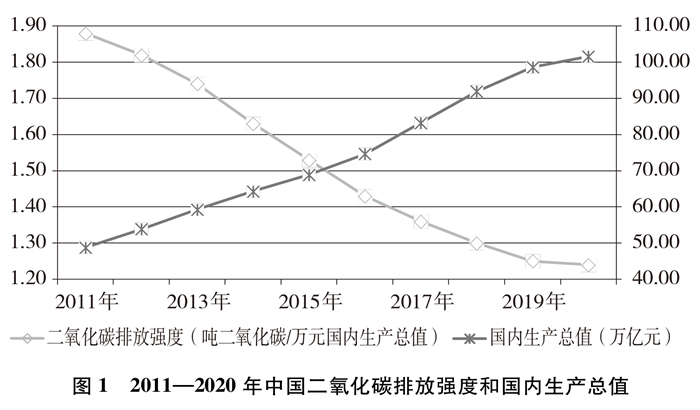
(二)能源生产和消费革命取得显著成效
2. Remarkable Results in Revolutionizing Energy Production and Consumption
中国坚定不移实施能源安全新战略,能源生产和利用方式发生重大变革,能源发展取得历史性成就,为服务高质量发展、打赢脱贫攻坚战和全面建成小康社会提供重要支撑,为应对气候变化、建设清洁美丽世界作出积极贡献。
China has committed to implementing a new energy security strategy, with major changes made in energy production and utilization, and historic achievements in energy development. These provide vital momentum to achieve high-quality development, win the battle against poverty, and build a moderately prosperous society in all respects. They also contribute to China’s drive to mitigate climate change and build a clean and beautiful world.

非化石能源快速发展。中国把非化石能源放在能源发展优先位置,大力开发利用非化石能源,推进能源绿色低碳转型。初步核算,2020年,中国非化石能源占能源消费总量比重提高到15.9%,比2005年大幅提升了8.5个百分点;中国非化石能源发电装机总规模达到9.8亿千瓦,占总装机的比重达到44.7%,其中,风电、光伏、水电、生物质发电、核电装机容量分别达到2.8亿千瓦、2.5亿千瓦、3.7亿千瓦、2952万千瓦、4989万千瓦,光伏和风电装机容量较2005年分别增加了3000多倍和200多倍。非化石能源发电量达到2.6万亿千瓦时,占全社会用电量的比重达到三分之一以上。
Non-fossil energy is developing rapidly. China gives priority to the development of non-fossil energy. It is vigorously developing and utilizing alternative energy sources, and promoting a green and low-carbon transformation of its energy industry. Preliminary calculations show that in 2020, non-fossil energy contributed 15.9 percent to China’s total energy consumption, a significant increase of 8.5 percentage points compared with 2005. The total installed capacity of non-fossil energy power generation in China reached 980 million kW, accounting for 44.7 percent of total installed capacity. Within this figure, wind represented 280 million kW, PV 250 million kW, hydro 370 million kW, biomass 29.52 million kW, and nuclear power 49.89 million kW. PV power increased by a factor of more than 3,000 compared with 2005, and wind by a factor of more than 200. Electricity generated by non-fossil energy reached 2.6 trillion kWh, representing more than one third of the power consumption of the country.
能耗强度显著降低。中国是全球能耗强度降低最快的国家之一,初步核算,2011年至2020年中国能耗强度累计下降28.7%。“十三五”期间,中国以年均2.8%的能源消费量增长支撑了年均5.7%的经济增长,节约能源占同时期全球节能量的一半左右。中国煤电机组供电煤耗持续保持世界先进水平,截至2020年底,中国达到超低排放水平的煤电机组约9.5亿千瓦,节能改造规模超过8亿千瓦,火电厂平均供电煤耗降至305.8克标煤/千瓦时,较2010年下降超过27克标煤/千瓦时。据测算,供电能耗降低使2020年火电行业相比2010年减少二氧化碳排放3.7亿吨。2016年至2020年,中国发布强制性能耗限额标准16项,实现年节能量7700万吨标准煤,相当于减排二氧化碳1.48亿吨;发布强制性产品设备能效标准26项,实现年节电量490亿千瓦时。
China is rapidly reducing its energy consumption intensity. Preliminary calculations show that the reduction from 2011 to 2020 reached 28.7 percent, one of the fastest in the world. During the 13th Five-year Plan period (2016-2020), China fueled an average annual economic growth of 5.7 percent with an average annual energy consumption growth of 2.8 percent, and the amount of energy it saved accounted for about half of the global energy savings in the same period. China has been ranked among leading countries in the efficiency of coal consumption in its coal-fired power generation units. By the end of 2020, it had approximately 950 million kW of installed capacity in ultra-low emission units, and over 800 million kW of installed capacity in units that had undergone energy-saving transformation. The average coal consumption of thermal power plants had decreased to 305.8 grams of standard coal per kWh, down more than 27 grams compared with 2010. The energy saved represents a reduction of 370 million tonnes of carbon dioxide emission by coal-fired power generation units in 2020 compared with 2010.
From 2016 to 2020, China issued 16 mandatory energy consumption quota standards, achieving an annual energy saving of 77 million tonnes of standard coal, equivalent to 148 million tonnes of carbon dioxide emissions; it issued 26 mandatory product and equipment energy efficiency standards, realizing an annual power saving of 49 billion kWh.
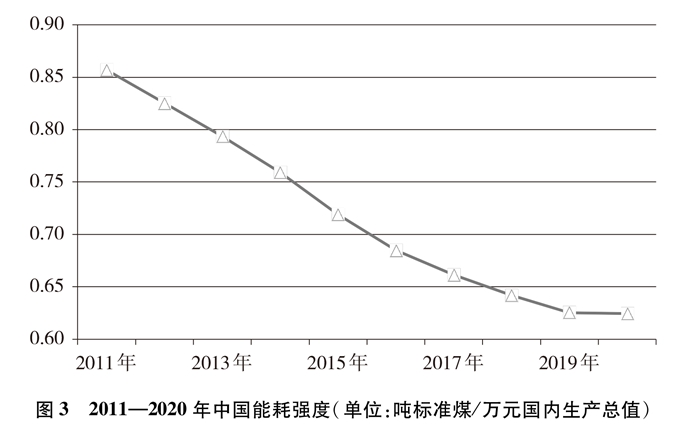
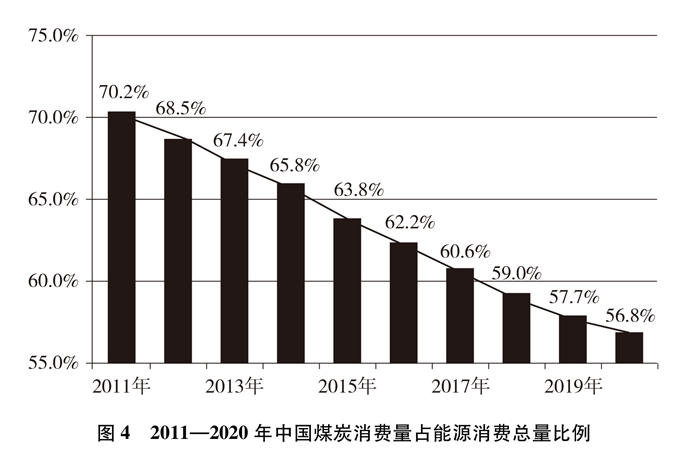
能源消费结构向清洁低碳加速转化。为应对化石能源燃烧所带来的环境污染和气候变化问题,中国严控煤炭消费,煤炭消费占比持续明显下降。2020年中国能源消费总量控制在50亿吨标准煤以内,煤炭占能源消费总量比重由2005年的72.4%下降至2020年的56.8%。中国超额完成“十三五”煤炭去产能、淘汰煤电落后产能目标任务,累计淘汰煤电落后产能4500万千瓦以上。截至2020年底,中国北方地区冬季清洁取暖率已提升到60%以上,京津冀及周边地区、汾渭平原累计完成散煤替代2500万户左右,削减散煤约5000万吨,据测算,相当于少排放二氧化碳约9200万吨。
China has accelerated the transformation to a clean and low-carbon energy consumption structure. In order to address pollution and climate change caused by fossil fuel combustion, China has strictly controlled coal consumption, and the proportion of coal consumption has continued to decline significantly. In 2020, China’s total energy consumption was kept under 5 billion tonnes of standard coal. The proportion of coal in its total energy consumption dropped from 72.4 percent in 2005 to 56.8 percent in 2020. China exceeded the target for reducing coal production capacity and eliminated more than 45 million kW of outdated coal and electricity production capacity during the 2016-2020 period. By the end of 2020, the clean heating rate in winter in northern China had increased to more than 60 percent. Coal for non-industrial sectors has been replaced with cleaner energy in the power supply to around 25 million households in Beijing, Tianjin, Hebei and surrounding areas and on the Fenwei Plain, representing a reduction of around 50 million tonnes of coal for non-industrial sectors, which is equivalent to cutting about 92 million tonnes of carbon dioxide emissions.
能源发展有力支持脱贫攻坚。中国实施能源扶贫工程,通过合理开发利用贫困地区能源资源,有效提升了贫困地区自身“造血”能力,为贫困地区经济发展增添新动能。中国累计建成超过2600万千瓦光伏扶贫电站,成千上万座“阳光银行”遍布贫困农村地区,惠及约6万个贫困村、415万贫困户,形成了光伏与农业融合发展的创新模式,助力打赢脱贫攻坚战。
Energy development significantly contributes to poverty alleviation. China has implemented a project to alleviate poverty through the rational development and utilization of energy resources in poor areas, effectively boosting their economic development capacity. China has built a total of more than 26 million kW of PV poverty-alleviation power stations, and thousands of “sunshine banks” in poor rural areas, benefiting about 60,000 poor villages and 4.15 million poor households. This innovative model for the integrated development of PV energy and agriculture is helping to win the battle against poverty.
(三)产业低碳化为绿色发展提供新动能
3. Low-Carbon Industrial Transition Fueling Green Development
中国坚持把生态优先、绿色发展的要求落实到产业升级之中,持续推动产业绿色低碳化和绿色低碳产业化,努力走出了一条产业发展和环境保护双赢的生态文明发展新路。
China has incorporated the concepts of putting the environment first and pursuing green development into its industrial upgrading. Through green, low carbon transformation of industries and the application of green, low carbon solutions, it has opened a new path to progress in both industrial development and environmental protection.
产业结构进一步优化。应对气候变化为中国产业绿色低碳发展赋予新使命,带来新机遇。2020年中国第三产业增加值占GDP比重达到54.5%,比2015年提高3.7个百分点,高于第二产业16.7个百分点。节能环保等战略性新兴产业快速壮大并逐步成为支柱产业,高技术制造业增加值占规模以上工业增加值比重为15.1%。“十三五”期间,中国高耗能项目产能扩张得到有效控制,石化、化工、钢铁等重点行业转型升级加速,提前两年完成“十三五”化解钢铁过剩产能1.5亿吨上限目标任务,全面取缔“地条钢”产能1亿多吨。据测算,截至2020年,中国单位工业增加值二氧化碳排放量比2015年下降约22%。2020年主要资源产出率比2015年提高约26%,废钢、废纸累计利用量分别达到约2.6亿吨、5490万吨,再生有色金属产量达到1450万吨。
China is improving its industrial structure. Responding to climate change is a new mission for Chinese industry in its pursuit of green, low-carbon development, which also opens up new opportunities. The added value of tertiary industry made up 54.5 percent of China’s GDP in 2020, 3.7 percentage points above that of 2015 and 16.7 percentage points higher than the figure for secondary industry. Strategic emerging industries such as energy conservation and environmental protection are growing rapidly and becoming pillars of the economy. Hi-tech manufacturing now accounts for 15.1 percent of the added value of industrial firms of designated size – with a revenue of RMB20 million and above per annum.
During the 2016-2020 period, China effectively reined in the expansion of energy-intensive industries, and accelerated the upgrading and transformation of key industries, including petrochemicals, chemicals, and iron & steel. Having set the goal of reducing the overcapacity of iron & steel production by up to 150 million tonnes during this period, it met the goal two years ahead of schedule, and decommissioned facilities producing substandard steel products to a total volume exceeding 100 million tonnes. It is estimated that from 2015 to 2020 carbon dioxide emissions per unit of added value of Chinese industries fell by about 22 percent.
In 2020, major resource productivity rose by approximately 26 percent from the 2015 level. About 260 million tonnes of scrap steel and 54.9 million tonnes of waste paper were reused, and the output of recycled non-ferrous metals reached 14.5 million tonnes.
新能源产业蓬勃发展。随着新一轮科技革命和产业变革孕育兴起,新能源汽车产业正进入加速发展的新阶段。中国新能源汽车生产和销售规模连续6年位居全球第一,截至2021年6月,新能源汽车保有量已达603万辆。中国风电、光伏发电设备制造形成了全球最完整的产业链,技术水平和制造规模居世界前列,新型储能产业链日趋完善,技术路线多元化发展,为全球能源清洁低碳转型提供了重要保障。截至2020年底,中国多晶硅、光伏电池、光伏组件等产品产量占全球总产量份额均位居全球第一,连续8年成为全球最大新增光伏市场;光伏产品出口到200多个国家及地区,降低了全球清洁能源使用成本;新型储能装机规模约330万千瓦,位居全球第一。
The new energy industry is witnessing strong growth. The latest revolution in science and technology and industrial transformation has accelerated the growth of the NEV industry. China has topped the world in NEV output and sales for the last six years. In June 2021 the country’s NEV fleet reached 6.03 million.
In the manufacture of wind power and PV power generation equipment, China has established the most complete industrial chain in the world, and is the global leader in terms of technology and output. The steady maturing of China’s industrial chain for new energy storage and the diversity of its technology lend strength to the clean, low-carbon transition of the global energy sector. As of the end of 2020, China had secured the largest share in the global output of polycrystalline silicon, PV cells, and PV modules, and led the world in PV capacity additions for eight consecutive years; it had exported PV products to more than 200 countries and regions worldwide, helping to bring down the cost of clean energy globally; its installed capacity for new energy storage stood at 3.3 million kW, the largest in the world.

绿色节能建筑跨越式增长。以绿色发展理念为牵引,中国全面深入推进绿色建筑和建筑节能,充分释放建筑领域巨大的碳减排潜力。截至2020年底,城镇新建绿色建筑占当年新建建筑比例高达77%,累计建成绿色建筑面积超过66亿平方米。累计建成节能建筑面积超过238亿平方米,节能建筑占城镇民用建筑面积比例超过63%。“十三五”期间,城镇新建建筑节能标准进一步提高,完成既有居住建筑节能改造面积5.14亿平方米,公共建筑节能改造面积1.85亿平方米。可再生能源替代民用建筑常规能源消耗比重达到6%。
Green, energy-efficient buildings are growing rapidly. Under its green development philosophy, China has made sweeping efforts to promote eco-friendly and energy-efficient buildings, in a bid to harness the full potential for carbon emissions reduction in the architectural sector. By the end of 2020 the floorage of China’s green buildings had exceeded 6.6 billion square meters, with as many as 77 percent of urban buildings completed in the year meeting the green standard. The floorage of energy-efficient buildings had surpassed 23.8 billion square meters, accounting for more than 63 percent of the total floor space of urban civic buildings.
During the 2016-2020 period China further raised its energy conservation standard for newly built urban buildings. It improved energy efficiency over 514 million square meters of floor space in existing civic buildings and 185 million square meters in public buildings, and increased the share of renewable energy in energy use by civic buildings to six percent.
绿色交通体系日益完善。中国坚定不移推进交通领域节能减排,走出了一条能耗排放做“减法”、经济发展做“加法”的新路子。综合运输网络不断完善,大宗货物运输“公转铁”、“公转水”、江海直达运输、多式联运发展持续推进;铁路货运量占全社会货运量比例较2017年增长近两个百分点,水路货运量较2010年增加了38.27亿吨,集装箱铁水联运量“十三五”期间年均增长超过23%。城市低碳交通系统建设成效显著,截至2020年底,31个省(区、市)中有87个城市开展了国家公交都市建设,43个城市开通运营城市轨道交通。“十三五”期间城市公共交通累计完成客运量超4270亿人次,城市公共交通机动化出行分担率稳步提高。
Steady progress is being made in green transport. China is firmly committed to energy conservation and emissions reduction in the transport industry. It has therefore devised a means of reducing energy consumption and carbon emissions while maintaining economic growth. With steady improvements to the integrated transport system, more bulk cargos are carried by train and ship instead of truck, and river-sea shipping and multimodal transport continue to expand. By 2020 the share of railways in China’s total freight volume had increased by nearly two percentage points over 2017, and the volume of river and sea freight had grown by 3.83 billion tonnes compared to 2010. Between 2016 and 2020 the volume of intermodal rail-water freight grew by an average of 23 percent year on year.
Notable progress has also been made in building low-carbon urban transport systems. As of the end of 2020, 87 cities on China’s mainland had joined the national program to improve public transport, and 43 cities had launched urban rail transit networks. During the 2016-2020 period, trips by urban public transport exceeded 427 billion, signifying a steady increase in the proportion of city dwellers using public transport.
(四)生态系统碳汇能力明显提高
4. Marked Increase in the Carbon Sink Capacity of Ecosystems
中国坚持多措并举,有效发挥森林、草原、湿地、海洋、土壤、冻土等的固碳作用,持续巩固提升生态系统碳汇能力。中国是全球森林资源增长最多和人工造林面积最大的国家,成为全球“增绿”的主力军。2010年至2020年,中国实施退耕还林还草约1.08亿亩。“十三五”期间,累计完成造林5.45亿亩、森林抚育6.37亿亩。2020年底,全国森林面积2.2亿公顷,全国森林覆盖率达到23.04%,草原综合植被覆盖度达到56.1%,湿地保护率达到50%以上,森林植被碳储备量91.86亿吨,“地球之肺”发挥了重要的碳汇价值。“十三五”期间,中国累计完成防沙治沙任务1097.8万公顷,完成石漠化治理面积165万公顷,新增水土流失综合治理面积31万平方公里,塞罕坝、库布齐等创造了一个个“荒漠变绿洲”的绿色传奇;修复退化湿地46.74万公顷,新增湿地面积20.26万公顷。截至2020年底,中国建立了国家级自然保护区474处,面积超过国土面积的十分之一,累计建成高标准农田8亿亩,整治修复岸线1200公里,滨海湿地2.3万公顷,生态系统碳汇功能得到有效保护。
China has taken various measures to build up the carbon sink capacity of ecosystems and ensure that forests, grasslands, wetlands, oceans, soil and frigid zones play their role in carbon sequestration. With the highest growth in forest coverage and the largest area of man-made forests, China leads the world in greening the planet. In the decade between 2010 and 2020, 7.2 million ha of marginal farmland were turned into forest and grassland. By 2020, vegetation coverage of its grasslands was 56.1 percent, and more than half of its wetland areas were under protection.
In the 2016-2020 period, 36.3 million ha of forests were planted, and 42.5 million ha of forests were tended. At the end of 2020, China’s forest area stood at 220 million ha, its forest coverage reached 23 percent, and forest carbon storage approached 9.19 billion tonnes. Forests, the lungs of the earth, are playing their due role as an important carbon sink.
During the five years from 2016 to 2020, China conducted desertification control on almost 11 million ha, addressed stony desertification on 1.65 million ha, and applied comprehensive treatment of soil erosion to an additional 310,000 square kilometers of land. Saihanba and Kubuqi are two shining examples of this “desert to oasis” miracle China has created. China also restored 467,400 ha of degraded wetlands, and added 202,600 ha of new wetlands.
By the end of 2020 China had established 474 national nature reserves, which accounted for more than one tenth of its land mass. It had cultivated 53.3 million ha of high-quality farmland, and restored 1,200 km of coastline and 23,000 ha of coastal wetlands. As a result, ecosystems are better conserved and geared to play their role as carbon sinks.
(五)绿色低碳生活成为新风尚
5. Green and Low Carbon Lifestyles Gaining Popularity
践行绿色生活已成为建设美丽中国的必要前提,也正在成为全社会共建美丽中国的自觉行动。中国长期开展“全国节能宣传周”“全国低碳日”“世界环境日”等活动,向社会公众普及气候变化知识,积极在国民教育体系中突出包括气候变化和绿色发展在内的生态文明教育,组织开展面向社会的应对气候变化培训。“美丽中国,我是行动者”活动在中国大地上如火如荼展开。以公交、地铁为主的城市公共交通日出行量超过2亿人次,骑行、步行等城市慢行系统建设稳步推进,绿色、低碳出行理念深入人心。从“光盘行动”、反对餐饮浪费、节水节纸、节电节能,到环保装修、拒绝过度包装、告别一次性用品,“绿色低碳节俭风”吹进千家万户,简约适度、绿色低碳、文明健康的生活方式成为社会新风尚。
Green living is a prerequisite for building a beautiful China, and every member of society has become conscious of the need and is ready to act. Through regular activities, including those for National Energy Conservation Week, National Low Carbon Day and World Environment Day, China educates the public about climate change. It also promotes the concept of eco-civilization, including climate change and green development, in the national education system, and organizes training courses for the public on responding to climate change.
The “Beautiful China, I’m a Contributor” campaign is sweeping the nation, attracting large numbers of participants. Urban public vehicles, mainly buses and subways, carry over 200 million passengers every day, roads and facilities friendly to cycling and walking are expanding in urban areas, and more people are favoring green, low-carbon modes of transport.
In addition, tens of thousands of households are practicing thrift through actions such as saving food, water, paper, and energy, choosing eco-friendly materials for home decoration, and saying no to over-packaging and disposable products. The nation is turning towards a thrifty, healthy, green and low-carbon lifestyle.









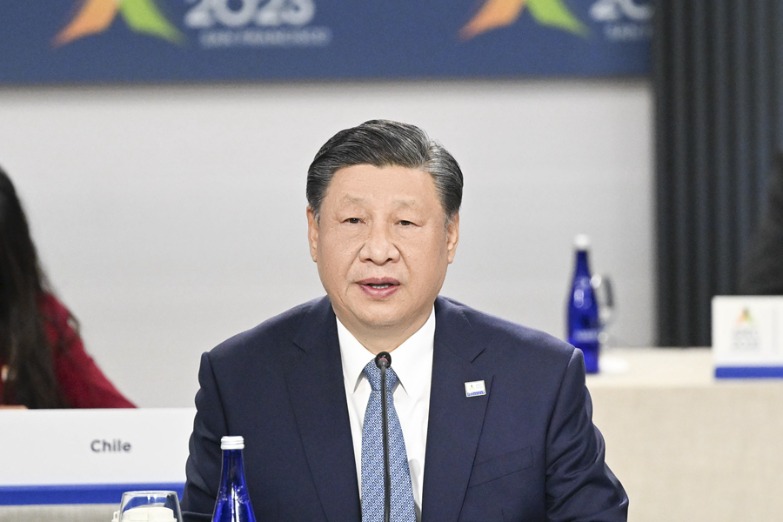


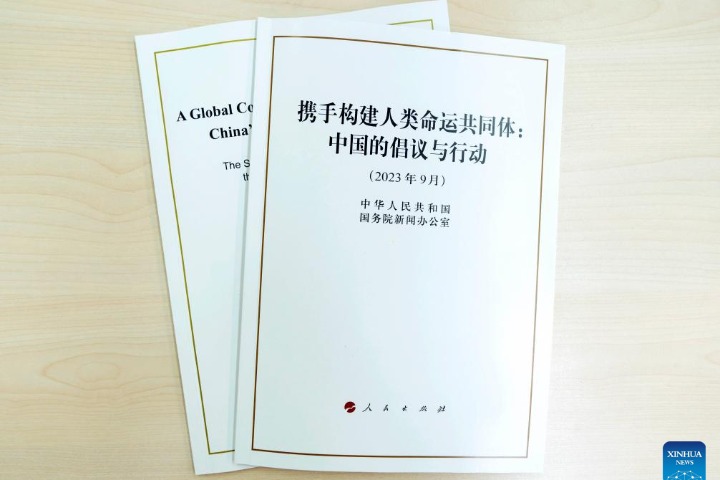
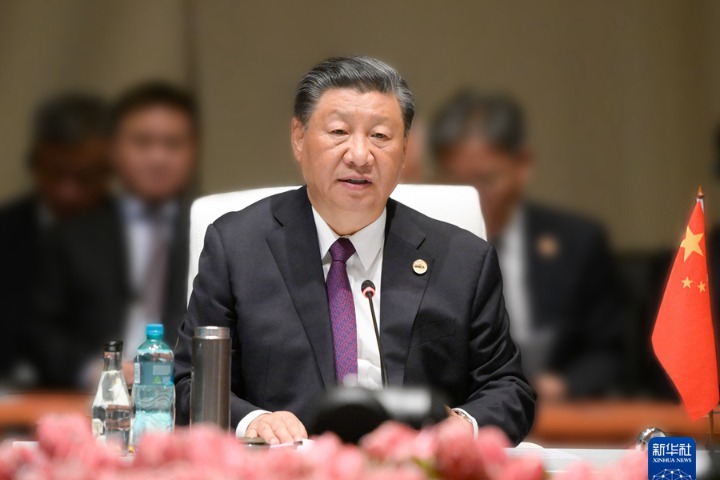



 英语点津微信
英语点津微信 双语小程序
双语小程序